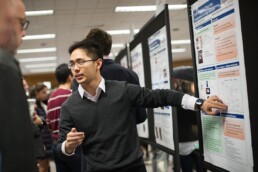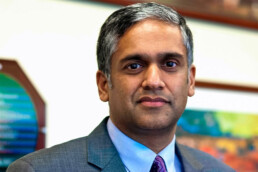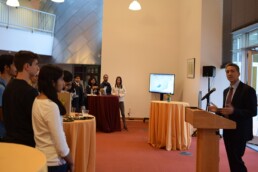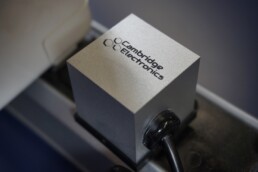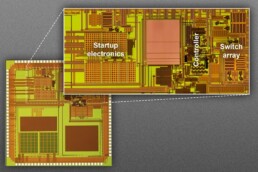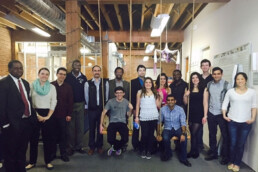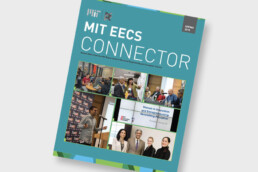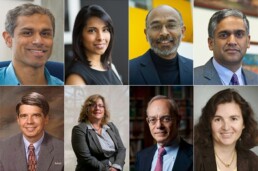Innovation on showcase
Undergrads present research at the SuperUROP Research Preview.
Innovation is about solving the right problem at the right time, Sophie Vandebroek, Xerox’s chief technology officer, told an audience of students participating in the School of Engineering’s SuperUROP program on Thursday.
“You have to focus on who is the user for your technology and what is the right problem to solve,” said Vandebroek, who is also president of the Xerox Innovation Group. “In the early 1970s, we had a color copier. It was amazing technology. There was just one problem: There were very few color originals.”
Today, Xerox sends experts into hospitals, schools, cities, and other environments to observe users, she noted — making sure the right problem is solved early in the innovation process.
It takes a network
Rising Stars workshop helps female electrical engineers and computer scientists build a professional network, find jobs in academia.
Success in higher education, especially for women in computer science and electrical engineering, takes a network. And while some connections are only a text message or tweet away, the personal touch still matters, and it works differently.
For graduate students like Judy Hoffman, who studies adaptive learning algorithms at the University of California at Berkeley, there is no substitute for actually meeting fellow female engineers and computer scientists in person. To make this happen, the Department of Electrical Engineering and Computer Science (EECS) hosts “Rising Stars in EECS,” a three-day workshop for graduate students and postdocs who are considering careers in academic research.
Chandrakasan appointed to Vannevar Bush Professorship
Department of Electrical Engineering and Computer Science head Anantha Chandrakasan appointed to Institute-wide professorship.
Anantha P. Chandrakasan has been appointed to the Vannevar Bush Professorship, effective Nov. 1, Dean of Engineering Ian A. Waitz has announced. The Vannevar Bush Professorship is an Institute-wide professorship established in 1982 as a memorial to one of the most outstanding scientists and engineers of the 20th century, who was also MIT’s first dean of the School of Engineering. Previous chair holders include Gerald L. Wilson, Subra Suresh, and Ronald L. Rivest.
“Professor Chandrakasan is an exceptionally talented leader, scholar, innovator, and educator,” Waitz wrote in an email announcing the appointment. “As Department Head in EECS he has led the implementation of many initiatives, several of which — including Start6 and SuperUROP — have been adopted across the School [of Engineering].”
SuperUROP undergrad research program goes engineering-wide
Yearlong “Super” Undergraduate Research Opportunities Program expands beyond electrical engineering and computer science.
Ian A. Waitz, dean of the School of Engineering, officially welcomed 183 students into the 2015-2016 SuperUROP class on Thursday, Sept. 30, at a Stata Center reception for participants in the program, which has more than doubled in size since its 2012 launch within the Department of Electrical Engineering and Computer Science (EECS).
Opened for the first time this year to students throughout the School of Engineering, the Advanced Undergraduate Research Opportunities Program — commonly known as SuperUROP — is a yearlong independent research program that builds on the success of MIT’s Undergraduate Research Opportunities Program (UROP). SuperUROP’s additional goals include requiring students to take a two-term course on undergraduate research and to produce prototypes or publication-worthy results.
Making the new silicon
Gallium nitride electronics could drastically cut energy usage in data centers, consumer devices.
An exotic material called gallium nitride (GaN) is poised to become the next semiconductor for power electronics, enabling much higher efficiency than silicon.
In 2013, the Department of Energy (DOE) dedicated approximately half of a $140 million research institute for power electronics to GaN research, citing its potential to reduce worldwide energy consumption. Now MIT spinout Cambridge Electronics Inc. (CEI) has announced a line of GaN transistors and power electronic circuits that promise to cut energy usage in data centers, electric cars, and consumer devices by 10 to 20 percent worldwide by 2025.
Toward tiny, solar-powered sensors
New ultralow-power circuit improves efficiency of energy harvesting to more than 80 percent.
The latest buzz in the information technology industry regards “the Internet of things” — the idea that vehicles, appliances, civil-engineering structures, manufacturing equipment, and even livestock would have their own embedded sensors that report information directly to networked servers, aiding with maintenance and the coordination of tasks.
Realizing that vision, however, will require extremely low-power sensors that can run for months without battery changes — or, even better, that can extract energy from the environment to recharge.
Start6 students expand innovation horizons while making connections in Silicon Valley
San Francisco and Silicon Valley startups, MIT alumni, and venture capitalists complement and enhance the Start6 learning experience.
Since the 2015 Start6 IAP class for innovators and entrepreneurs ended in mid January, the MIT students who took part were eager to continue another phase of their Start6 experience by venturing to California’s Silicon Valley and San Francisco’s startup culture during spring break in mid March. For two days, over 30 members of the Start6 class were given the opportunity to visit and network at Airware, AppDynamics, Khan Academy, Lemnos Labs, Nutanix, Pinterest, Quizlet, and Wearable Intelligence as well as attend several alumni receptions and meet with venture capitalists (VCs).
“I was lucky to pick two great companies for my visits,” says David Ogutu, a senior in MIT’s Department of Civil and Environmental Engineering. Ogutu chose to visit Wearable Intelligence and Quizlet — both early-stage but expanding startups. “It was impressive to see just how much you can do with a small force of engineers,” he said. “Seeing the companies in action was very encouraging and worth more than 10 talks.”
The 2015 Connector is out! Annual news from the MIT EECS Department
Read the latest MIT EECS Connector (Spring 2015) online. Choose from several possible versions (single pages or spreads) or in slightly animated version on ISSUU.
The 2015 Connector features news about the EECS Department's faculty, students, staff and alumni and the groundbreaking initiatives and milestones celebrated this past year by the department's affiliate labs and more.
Radio chip for the “Internet of things”
Circuit that reduces power leakage when transmitters are idle could greatly extend battery life.
At this year’s Consumer Electronics Show in Las Vegas, the big theme was the “Internet of things” — the idea that everything in the human environment, from kitchen appliances to industrial equipment, could be equipped with sensors and processors that can exchange data, helping with maintenance and the coordination of tasks.
Realizing that vision, however, requires transmitters that are powerful enough to broadcast to devices dozens of yards away but energy-efficient enough to last for months — or even to harvest energy from heat or mechanical vibrations.
Anantha Chandrakasan among eight from MIT elected to National Academy of Engineering
New members include the Institute’s president and the director of Lincoln Laboratory.
Eight members of the MIT community — Hari Balakrishnan, Sangeeta Bhatia, Emery N. Brown, Anantha Chandrakasan, Eric D. Evans, Karen K. Gleason, L. Rafael Reif, and Daniela Rus — are among the 67 new members and 12 foreign associates elected today to the National Academy of Engineering (NAE).
Election to the NAE is among the highest professional distinctions accorded to American engineers. Academy membership honors those who have made outstanding contributions to “engineering research, practice, or education, including, where appropriate, significant contributions to the engineering literature,” and to the “pioneering of new and developing fields of technology, making major advancements in traditional fields of engineering, or developing/implementing innovative approaches to engineering education.”
Future MIT entrepreneurs get boost through Start6
Three-week credit class opens opportunities for MIT students.
MIT’s next generation of entrepreneurs is getting a leg up on the competition thanks to Start6, an innovative class offered Jan. 12-27 by the Department of Electrical Engineering and Computer Science (EECS) that teaches students what’s needed to launch and run a successful startup business.
Keynote speakers for the class include Dropbox founder Drew Houston ’05, Google vice president Jeremy Wertheimer SM '89, PhD '96, and Ethernet co-inventor Robert Metcalfe, the founder of 3Com. The class also features mentoring, field trips, and panel discussions on entrepreneurship paths, marketing techniques, and funding strategies.
